Lexus CT200h 2011 Owner's Manual (in English)
Manufacturer: LEXUS, Model Year: 2011, Model line: CT200h, Model: Lexus CT200h 2011Pages: 696
Page 281 of 696

281
2-4. Using other driving systems
2
When driving
CT200h_EE (OM76041E)
Rear view monitor system camera
The camera uses a special lens. The
distance of the image that appears on
the screen differs from the actual dis-
tance.
In the following cases, it may be diffi-
cult to see the images on the screen,
even when the system is functioning
correctly.
• In the dark (e.g. at night).
• If the temperature near the lens is
extremely high or low.
• If water droplets get on the camera,
or when humidity is high (e.g. when
it rains).
• If foreign matter (e.g. snow or mud)
get on the camera lens.
• If the sun or headlights are shining
directly into the camera lens.
• When the camera has scratches or
dirt on it.
• A bright object such as a white wall
is reflected in the mirror surface
over the monitor.
• When the camera is used under flu-
orescent light, sodium lights, or
li h h li h d
Page 282 of 696

282
2-4. Using other driving systems
CT200h_EE (OM76041E)
Smear effect
Flicker effect
When the camera is used under fluorescent lights, sodium lights, mercury
lights, etc., the lights and the illuminated areas may appear to flicker.
If a bright light (e.g. sunlight reflected off
the vehicle body) is picked up by the
camera, a smear effect
* peculiar to the
camera may occur.
*: Smear effect — A phenomenon that
occurs when a bright light (for exam-
ple, sunlight reflected off the vehicle
body) is picked up by the camera;
when transmitted by the camera, the
light source appears to have a vertical
streak above and below it.
Page 283 of 696
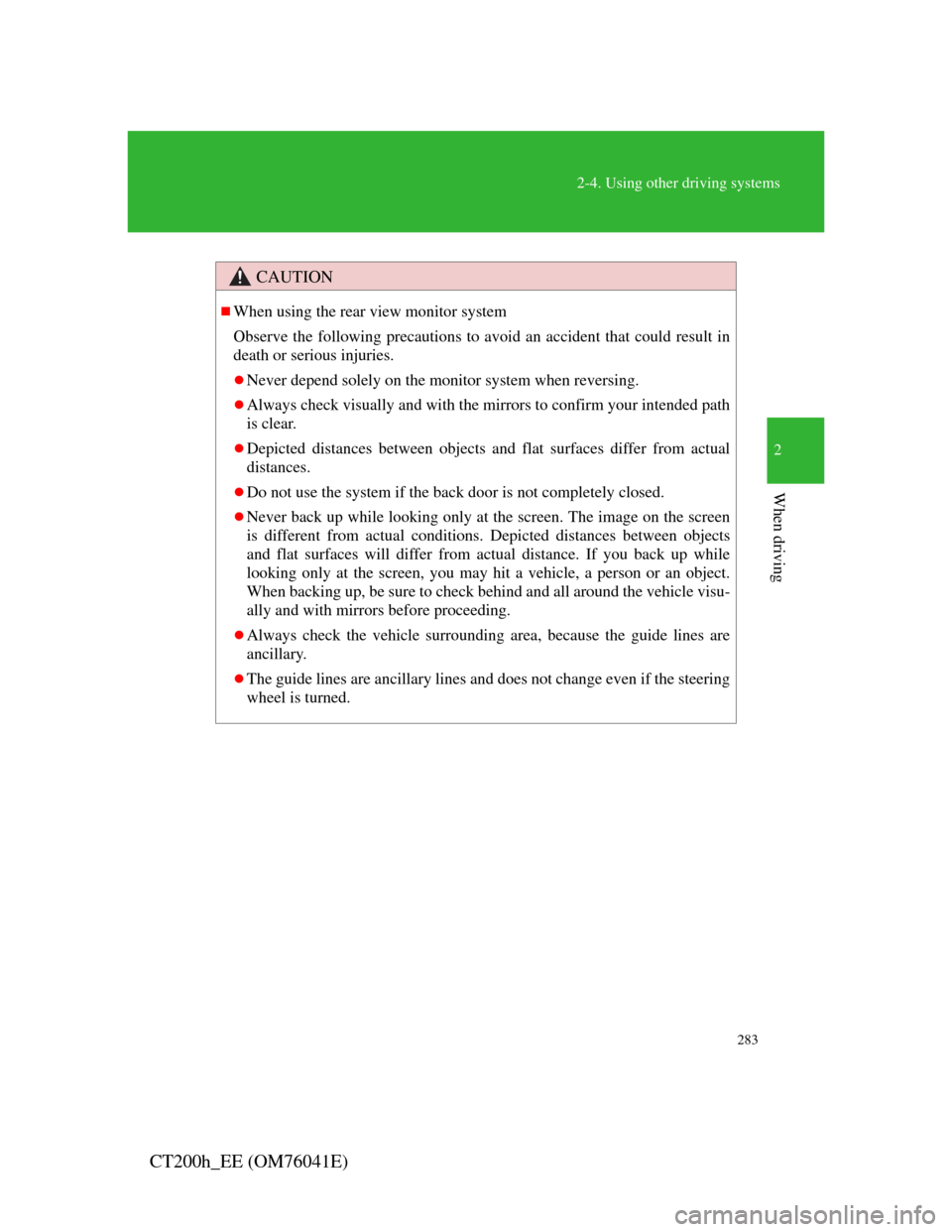
283
2-4. Using other driving systems
2
When driving
CT200h_EE (OM76041E)
CAUTION
When using the rear view monitor system
Observe the following precautions to avoid an accident that could result in
death or serious injuries.
Never depend solely on the monitor system when reversing.
Always check visually and with the mirrors to confirm your intended path
is clear.
Depicted distances between objects and flat surfaces differ from actual
distances.
Do not use the system if the back door is not completely closed.
Never back up while looking only at the screen. The image on the screen
is different from actual conditions. Depicted distances between objects
and flat surfaces will differ from actual distance. If you back up while
looking only at the screen, you may hit a vehicle, a person or an object.
When backing up, be sure to check behind and all around the vehicle visu-
ally and with mirrors before proceeding.
Always check the vehicle surrounding area, because the guide lines are
ancillary.
The guide lines are ancillary lines and does not change even if the steering
wheel is turned.
Page 284 of 696

284
2-4. Using other driving systems
CT200h_EE (OM76041E)
CAUTION
Conditions which may affect the rear view monitor system
If the back of the vehicle has been hit, the camera’s position and mounting
angle may have been changed. Have the vehicle inspected by any autho-
rized Lexus dealer or repairer, or another duly qualified and equipped pro-
fessional.
Rapid temperature changes, such as when hot water is poured on the vehi-
cle in cold weather, may cause the system to function abnormally.
If the camera lens is dirty, it cannot transmit a clear image. Rinse with
water and wipe with a soft cloth. If the camera lens is extremely dirty,
wash with a mild cleanser and rinse.
The displayed image may be darker and moving images may be slightly
distorted when the system is cold.
When washing the vehicle, do not apply intensive bursts of water to the
camera or camera area. Doing so may result in the camera malfunctioning.
Do not allow organic solvent, car wax, window cleaner or glass coat to
adhere to the camera. If this happens, wipe it off as soon as possible.
As the camera has a water proof construction, do not detach, disassemble
or modify it. This may cause incorrect operation.
Do not hit the camera or subject it to strong impacts as this may cause its
position and mounting angle to change.
Do not scrub the camera lens roughly or clean it with a hard brush or abra-
sive cleaner. Doing so may damage the lens and adversely affect the
image.
Page 285 of 696
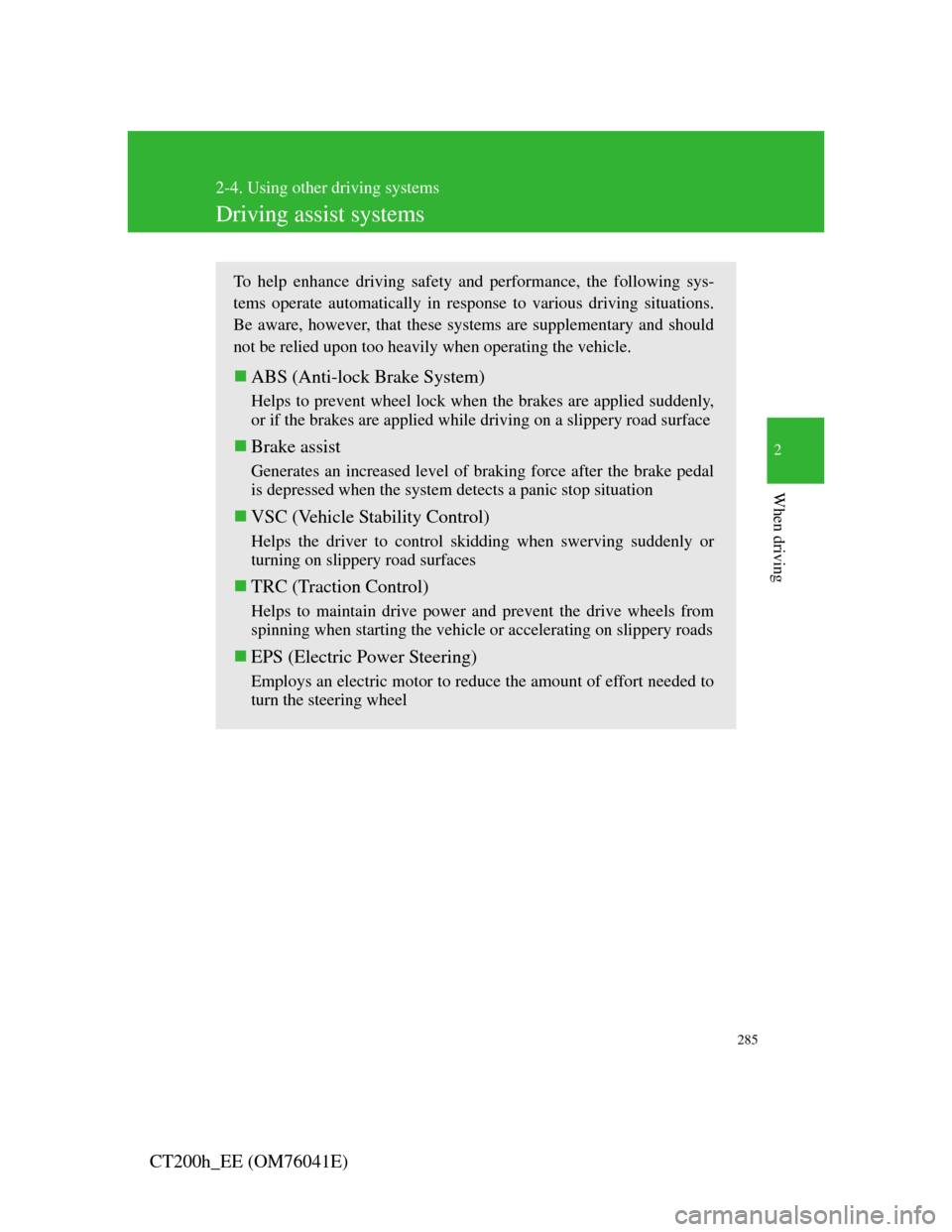
285
2-4. Using other driving systems
2
When driving
CT200h_EE (OM76041E)
Driving assist systems
To help enhance driving safety and performance, the following sys-
tems operate automatically in response to various driving situations.
Be aware, however, that these systems are supplementary and should
not be relied upon too heavily when operating the vehicle.
ABS (Anti-lock Brake System)
Helps to prevent wheel lock when the brakes are applied suddenly,
or if the brakes are applied while driving on a slippery road surface
Brake assist
Generates an increased level of braking force after the brake pedal
is depressed when the system detects a panic stop situation
VSC (Vehicle Stability Control)
Helps the driver to control skidding when swerving suddenly or
turning on slippery road surfaces
TRC (Traction Control)
Helps to maintain drive power and prevent the drive wheels from
spinning when starting the vehicle or accelerating on slippery roads
EPS (Electric Power Steering)
Employs an electric motor to reduce the amount of effort needed to
turn the steering wheel
Page 286 of 696
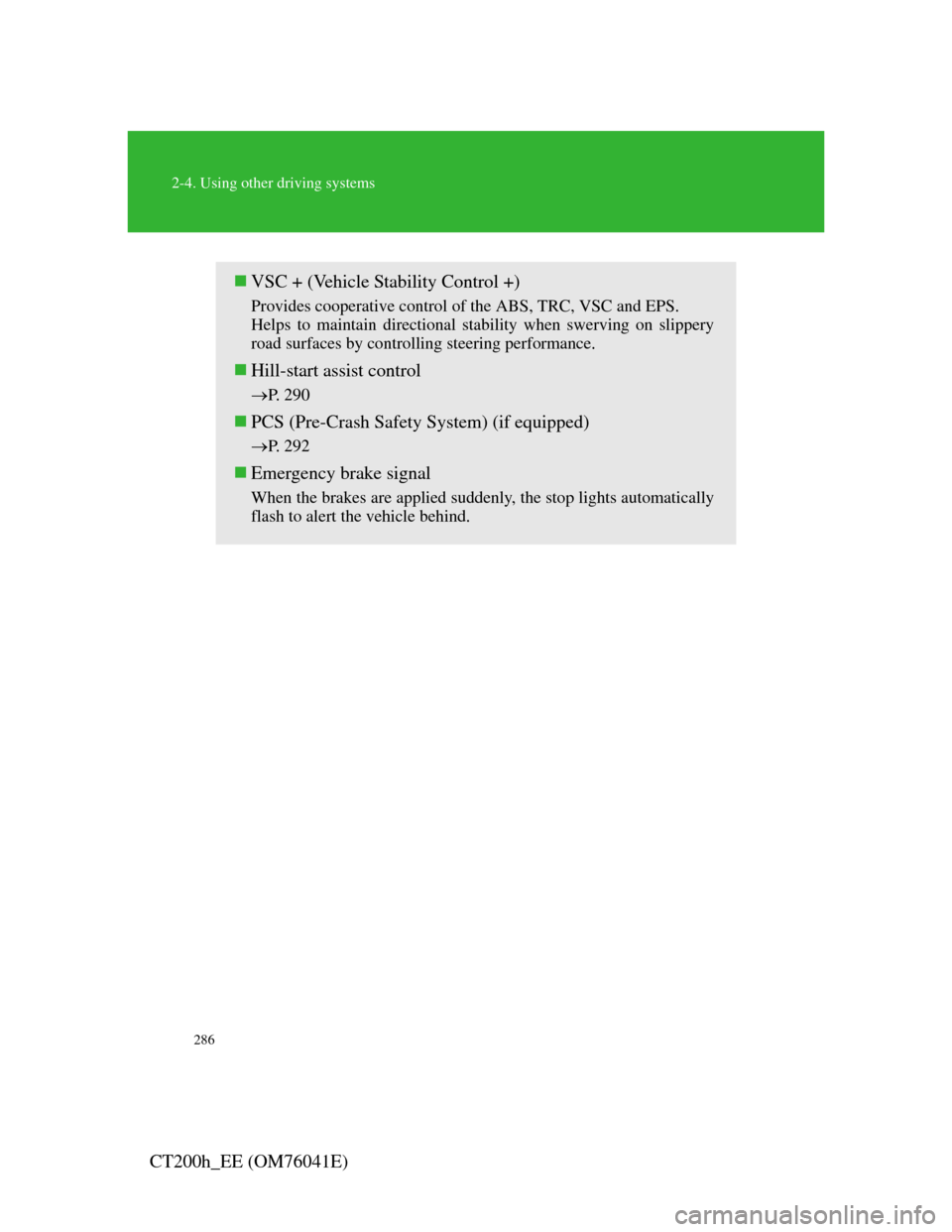
286
2-4. Using other driving systems
CT200h_EE (OM76041E)
VSC + (Vehicle Stability Control +)
Provides cooperative control of the ABS, TRC, VSC and EPS.
Helps to maintain directional stability when swerving on slippery
road surfaces by controlling steering performance.
Hill-start assist control
P. 290
PCS (Pre-Crash Safety System) (if equipped)
P. 292
Emergency brake signal
When the brakes are applied suddenly, the stop lights automatically
flash to alert the vehicle behind.
Page 287 of 696
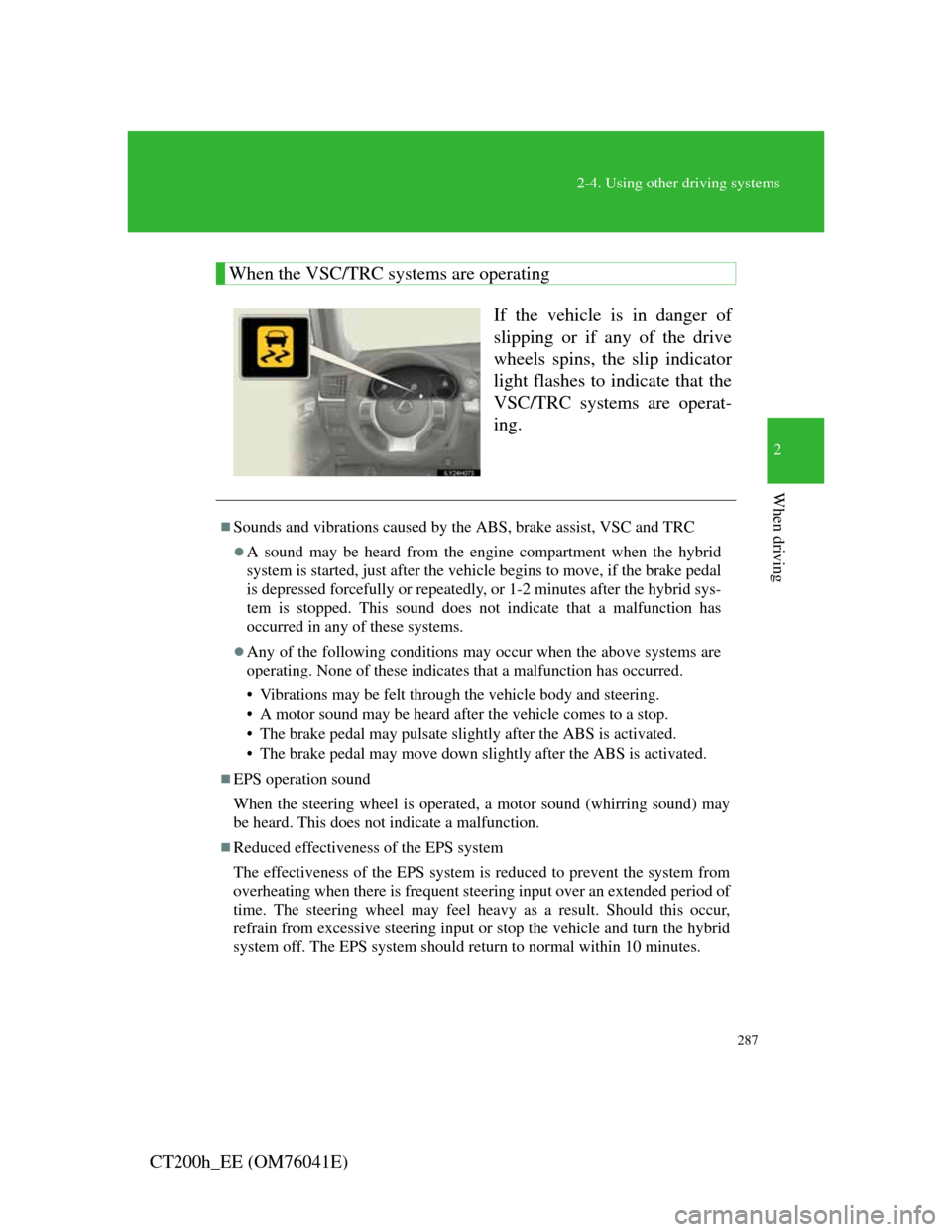
287
2-4. Using other driving systems
2
When driving
CT200h_EE (OM76041E)
When the VSC/TRC systems are operating
If the vehicle is in danger of
slipping or if any of the drive
wheels spins, the slip indicator
light flashes to indicate that the
VSC/TRC systems are operat-
ing.
Sounds and vibrations caused by the ABS, brake assist, VSC and TRC
A sound may be heard from the engine compartment when the hybrid
system is started, just after the vehicle begins to move, if the brake pedal
is depressed forcefully or repeatedly, or 1-2 minutes after the hybrid sys-
tem is stopped. This sound does not indicate that a malfunction has
occurred in any of these systems.
Any of the following conditions may occur when the above systems are
operating. None of these indicates that a malfunction has occurred.
• Vibrations may be felt through the vehicle body and steering.
• A motor sound may be heard after the vehicle comes to a stop.
• The brake pedal may pulsate slightly after the ABS is activated.
• The brake pedal may move down slightly after the ABS is activated.
EPS operation sound
When the steering wheel is operated, a motor sound (whirring sound) may
be heard. This does not indicate a malfunction.
Reduced effectiveness of the EPS system
The effectiveness of the EPS system is reduced to prevent the system from
overheating when there is frequent steering input over an extended period of
time. The steering wheel may feel heavy as a result. Should this occur,
refrain from excessive steering input or stop the vehicle and turn the hybrid
system off. The EPS system should return to normal within 10 minutes.
Page 288 of 696
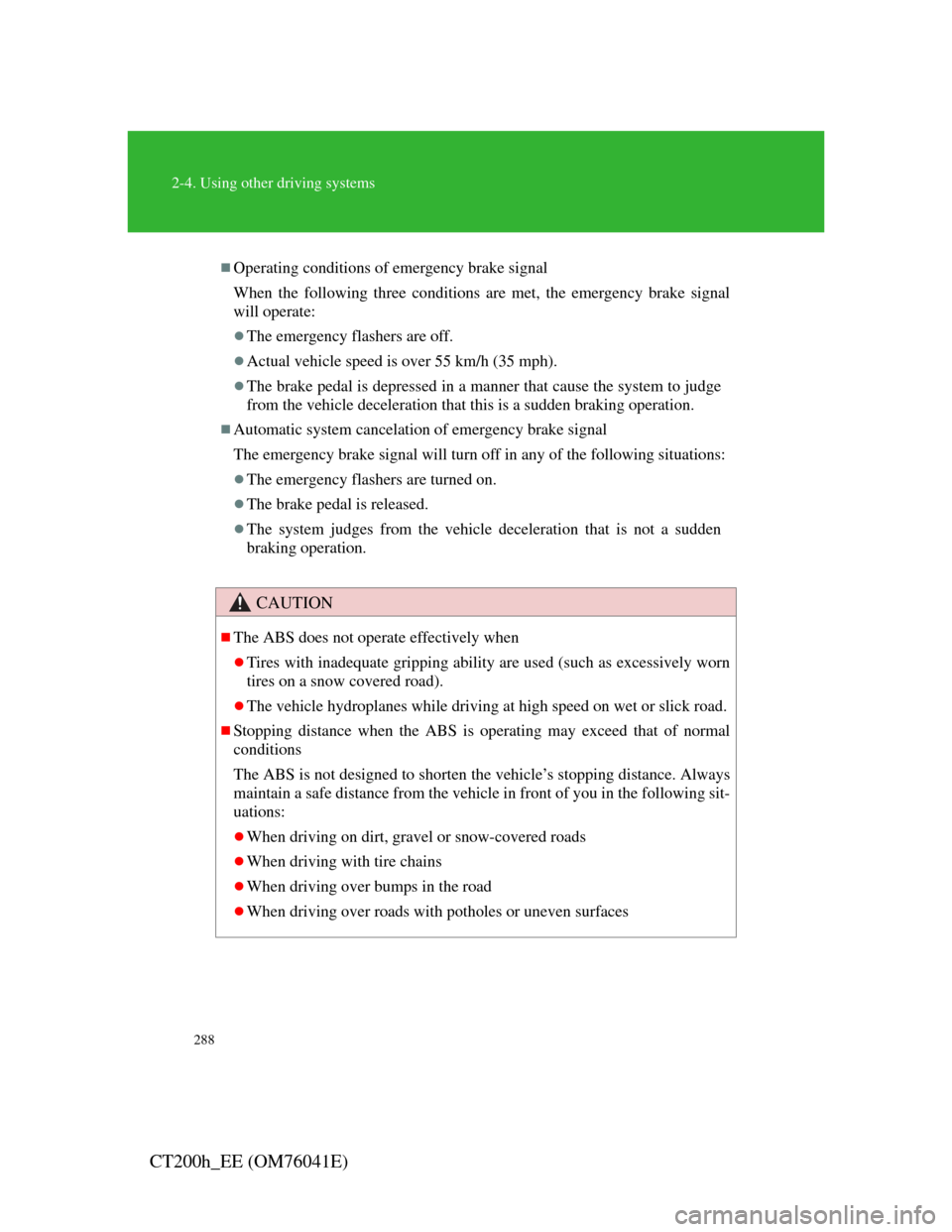
288
2-4. Using other driving systems
CT200h_EE (OM76041E)
Operating conditions of emergency brake signal
When the following three conditions are met, the emergency brake signal
will operate:
The emergency flashers are off.
Actual vehicle speed is over 55 km/h (35 mph).
The brake pedal is depressed in a manner that cause the system to judge
from the vehicle deceleration that this is a sudden braking operation.
Automatic system cancelation of emergency brake signal
The emergency brake signal will turn off in any of the following situations:
The emergency flashers are turned on.
The brake pedal is released.
The system judges from the vehicle deceleration that is not a sudden
braking operation.
CAUTION
The ABS does not operate effectively when
Tires with inadequate gripping ability are used (such as excessively worn
tires on a snow covered road).
The vehicle hydroplanes while driving at high speed on wet or slick road.
Stopping distance when the ABS is operating may exceed that of normal
conditions
The ABS is not designed to shorten the vehicle’s stopping distance. Always
maintain a safe distance from the vehicle in front of you in the following sit-
uations:
When driving on dirt, gravel or snow-covered roads
When driving with tire chains
When driving over bumps in the road
When driving over roads with potholes or uneven surfaces
Page 289 of 696
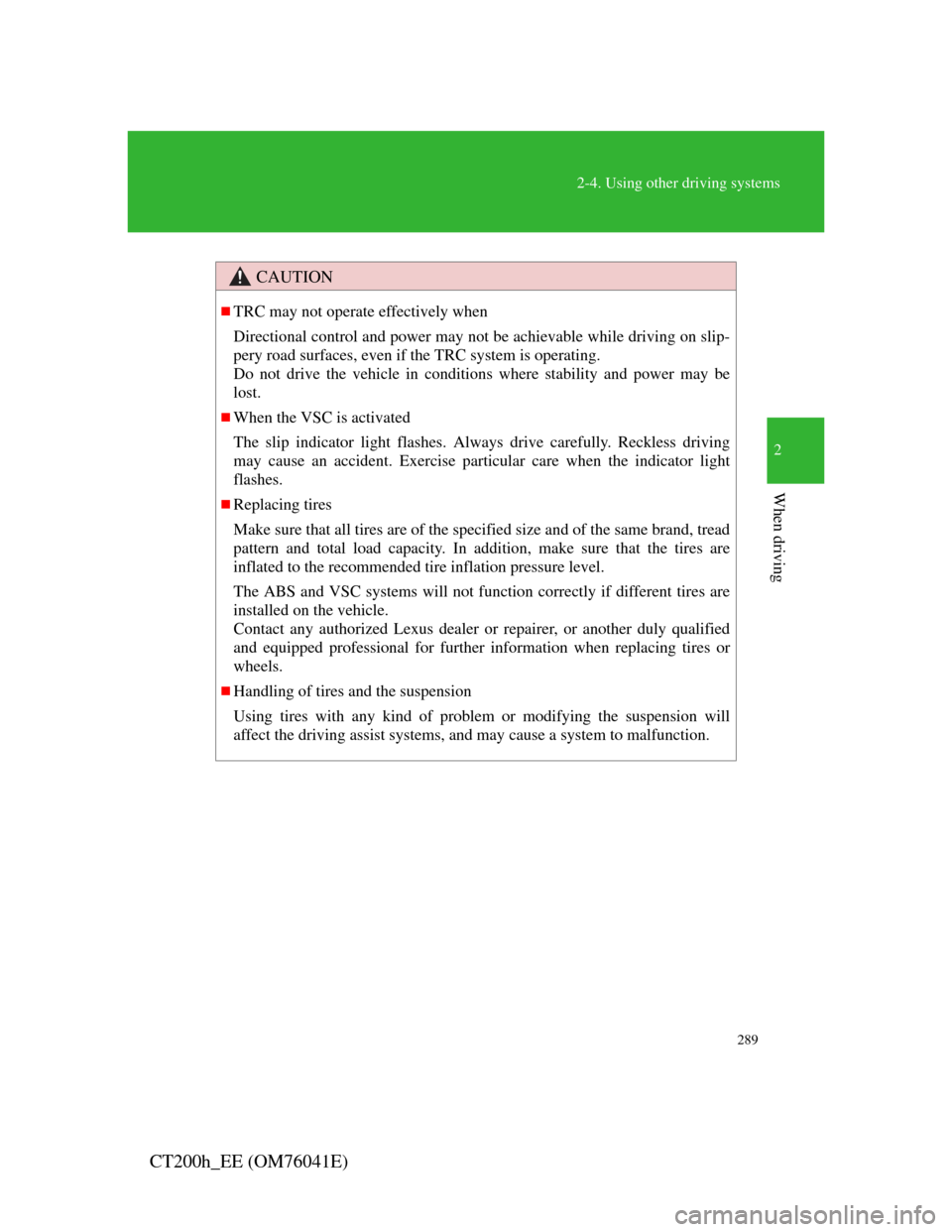
289
2-4. Using other driving systems
2
When driving
CT200h_EE (OM76041E)
CAUTION
TRC may not operate effectively when
Directional control and power may not be achievable while driving on slip-
pery road surfaces, even if the TRC system is operating.
Do not drive the vehicle in conditions where stability and power may be
lost.
When the VSC is activated
The slip indicator light flashes. Always drive carefully. Reckless driving
may cause an accident. Exercise particular care when the indicator light
flashes.
Replacing tires
Make sure that all tires are of the specified size and of the same brand, tread
pattern and total load capacity. In addition, make sure that the tires are
inflated to the recommended tire inflation pressure level.
The ABS and VSC systems will not function correctly if different tires are
installed on the vehicle.
Contact any authorized Lexus dealer or repairer, or another duly qualified
and equipped professional for further information when replacing tires or
wheels.
Handling of tires and the suspension
Using tires with any kind of problem or modifying the suspension will
affect the driving assist systems, and may cause a system to malfunction.
Page 290 of 696

290
2-4. Using other driving systems
CT200h_EE (OM76041E)
Hill-start assist control
Hill-start assist control can be operated when
The shift position is in a position other than P.
The parking brake is not applied.
The accelerator pedal is not depressed.
Hill-start assist control
While hill-start assist control is operating, the brakes remain automati-
cally applied after the driver releases the brake pedal. The stop lights and
the high mounted stoplight turn on.
Hill-start assist control operates for about 2 seconds after the brake pedal
is released.
If the slip indicator does not flash and the buzzer does not sound when
the brake pedal is further depressed, slightly reduce the pressure on the
brake pedal (do not allow the vehicle to roll backward) and then firmly
depress it again. If the system still does not operate, check if the operat-
ing conditions explained above have been met.
Hill-start assist control helps to prevent the vehicle from rolling back-
wards when starting on an incline or slippery slope.
To engage hill-start assist
control, further depress the
brake pedal when the vehicle
is stopped completely.
A buzzer will sound once to
indicate the system is acti-
vated. The slip indicator will
also start flashing.